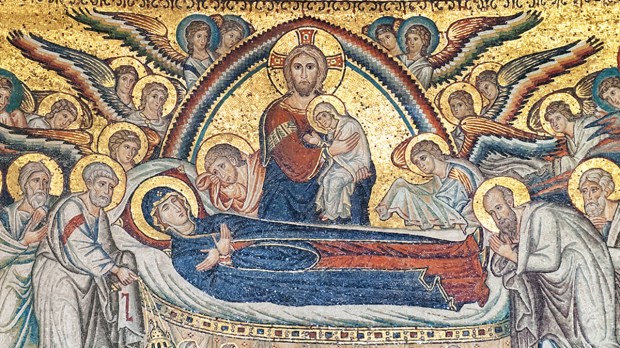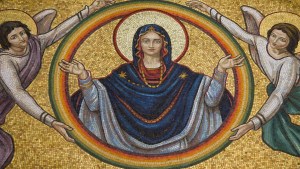In the iconography of the Dormition of the Virgin Mary, the depiction of Jesus holding a swaddled infant is a deeply evocative, theologically loaded image. It openly contrasts with more familiar depictions of the Virgin Mary cradling the infant Jesus. The image is deeply rooted in Eastern Christian traditions – particularly in the Byzantine artistic and theological context.
This iconographic motif (her soul, depicted as a newborn child, received into the embrace of Christ) serves as a visual, contemplative summary of the theological developments surrounding the Dormition and Assumption of the Virgin Mary.
The Dormition of the Theotokos is celebrated with solemnity in the Eastern Orthodox and Eastern Catholic Churches on August 15. The feast commemorates the “falling asleep” of the Virgin Mary, and her subsequent bodily assumption into heaven.
This feast highlights Mary’s unique role in the history of salvation. Indeed, Mariology is a theological science that has slowly but surely deepened and developed over the centuries, and so the icon of the Dormition offers a rich visual synthesis of these theological advances, with the image of Christ holding Mary’s soul as a child being perhaps the most striking, enduring, and revealing element.

In the icon, Jesus holds a swaddled newborn child, representing Mary’s soul, which he receives at the moment of her death. Theologically, this image embodies the idea of Mary being the firstborn of the new Creation. Whereas Jesus is often referred to as the New Adam, Mary is referred as the “New Eve.” This is what is known as typology.
Simply put, typology is a typically Christian way to read the Bible. Typology, often referred to as “figurative foreshadowing,” involves interpreting certain persons, events, or objects in the Hebrew Bible as foreshadowing or prefiguring their fulfillment in the Gospels. These “types” are seen as shadows or glimpses of the ultimate reality, the “antitypes,” found in the person of Jesus Christ. Eve is clearly the “type” of Mary, and Mary the “antitype of Eve.”
But here’s an important turning point: Whereas in the book of Genesis Adam physically precedes Eve, in the Gospels Mary physically precedes Jesus: she is indeed the firstborn of the New Creation.
Byzantine traditions
The image of Christ cradling Mary’s soul is particularly notable in the Byzantine tradition, where it reflects broader theological themes surrounding the Dormition. In Eastern Christian thought, this moment is not simply about death; it is a transformative passage in which Mary, the Theotokos is united with her Son in the heavenly realm. This union is visually expressed through the image of Christ cradling Mary’s infant soul, symbolizing her birth into new, eternal life, and the close, unbreakable bond between Mother and Son.
This depiction is vividly illustrated in the mosaics of the Chora Church in Istanbul – an absolute masterpiece of Byzantine art. In this mosaic, Jesus, surrounded by a radiant mandorla, stands holding the soul of Mary as an infant – also poignant typological reversal of the traditional icon of Mary holding the Christ Child.
The iconography of the Dormition also reflects the theological belief that Mary, as the vessel through which God became incarnate, was preserved from the corruption of death. This is also emphasized in the doctrine of the Assumption, formally defined in Western Christianity by Pope Pius XII in 1950 – but already deeply rooted in earlier Eastern and Western traditions.
According to these beliefs, Mary’s Assumption serves as a foretaste of the resurrection promised to all believers, with her bodily Assumption foreshadowing the general resurrection that will take place at the end of time.
Thomas, arriving late
Later traditions elaborate on the details of Mary’s Assumption. Most describe how the apostles, scattered throughout the world, were miraculously brought to her side at the time of her death. In particular, Thomas, who arrived late, witnessed her body being taken up to heaven and received her girdle as a tangible relic of her assumption. This narrative reinforces the Eastern Orthodox teaching that the Theotokos has already undergone the bodily resurrection and stands in heaven in a glorified state that the righteous will attain only after the Last Judgment.



